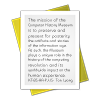Title
Wilkes, Art interviewCatalog Number
102738826Type
DocumentDescription
After graduating from Texas Western in 1964, Art Wilkes joined AT&T’s management training program. Two years later he became a West Coast sales manager. One of his main clients was Scantlin Electronics (SE) and Wilkes was responsible for selling them telephone lines to support their Quotron stock price transmission service. Company founder, Jack Scantlin, had invented a state-of-the art frequency division multiplexer (FDM) capable of connecting 150 terminals to a single shared phone line. When Wilkes was offered a significant salary raise to work for SE, he accepted, becoming lead salesman for the Quotron system.At SE he sold multiplexers to businesses that used teletype, telegraph and other slower-rate terminals, allowing them to combine these connections over single phone lines. One customer, Allen-Babcock, was interested in using multiplexers for their new timesharing service. Wilkes saw the opportunity and acted on it. He left Scantlin with an agreement to give up his stock options in return for the licensing rights to a new time division multiplexer (TDM), a significant improvement over FDM, that Scantlin had been developing.
With the idea for a TDM, he recruited his former college roommate, Bill Norred, to join him. When Norred and his new bride arrived at Wilkes’ doorstep in 1968, Wilkes had to inform Norred that the financing he had secured had fallen through. So rather than find their own apartment, Norred and his bride moved into Wilkes’ den and the two partners began working in Wilkes’ garage. Over the course of the next six months, Norred and Wilkes completed a working prototype of the 660 multiplexer, the flagship product of American Data Systems (ADS). They incorporated ADS that spring. Allen-Babcock became one of their first customers.
With an investment of $100,000 from Wilkes’ neighbor and the addition of Bob Schaaf, a former colleague from Scantlin, as head of sales, ADS was off and running. Their timing couldn’t have been better; in addition to the demand for sharing communication lines, timesharing computing was also taking hold. ADS grew quickly and by 1970 had sales of $5 million. In an effort to increase their product line they made an agreement with Rockwell International, which had developed an automatically equalized 4800 bps modem, to license the modem for controlling ownership of the company. The modem didn’t work, however, and the struggle to get it working left them low on cash and behind Codex and Milgo, which had introduced similar modems. When the timesharing business began to dry up in the following year, and the economy took a downturn, ADS saw orders cancelled and a slump in sales. Having purchased ADS competitor, Collins Radio, The Rockwell controlled board decided to trim ADS down to a shell and replaced Wilkes with a new president from Rockwell.
In this interview, Wilkes offers unique insights on the early development of data communications, both as a manager with the largest communications company of the day, and as one of the early entrepreneurial success stories of the new data com market. His work with AT&T gave him specific understanding of the potential future of communications. He recollects one early study done by an AT&T study group that asked: “Will, by the year 2000, we have ‘a terminal per person?’” His work with the FCC to help ease tariffs for new data communications technology put him at the forefront of technology and regulation, giving him unique knowledge and understanding that he applied effectively to his startup.
Date
1988-05-09Contributor
| Pelkey, James L., Interviewer |
| Robbins, Loring, Editor |
| Wilkes, Art, Interviewee |
Publisher
Computer History MuseumPlace of Publication
Chatsworth, CAExtent
26 p.Format
PDFCategory
TranscriptionSubject
AT&T; Scantlin Electronics; Quotron; American Data Systems (ADS); Frequency Division multiplexer; Time Division Multiplexer; RockwellCollection Title
James L. Pelkey collection : history of computer communicationsCredit
Gift of James PelkeyLot Number
X5671.2010Related Records
| 102746648 | James L. Pelkey collection : history of computer communications |


